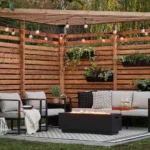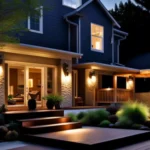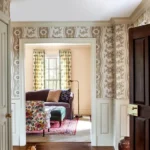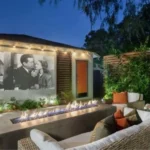Lighting to Set the Mood is a powerful design element that transforms any room into a functional and visually captivating space.
The right lighting not only illuminates a room but also defines its ambiance, whether it’s cozy, vibrant, or serene.
By strategically combining ambient, task, and accent lighting, you can create tailored atmospheres that enhance both aesthetics and functionality.
Understanding how light intensity, color temperature, and placement influence a room allows you to evoke specific emotions and improve usability.
From sophisticated dining areas to tranquil bedrooms, effective lighting design is essential.
This guide will show you how to master lighting techniques, choose the best fixtures, and set the perfect mood for any space.
Understanding the Basics of Lighting
Lighting is a combination of science and art. Before diving into specific room ideas, it’s essential to understand the three primary types of lighting:
Ambient Lighting
This is the room’s general lighting, providing overall illumination. Ambient lighting ensures a space is well-lit and functional. Examples include ceiling fixtures, chandeliers, and recessed lighting.
Task Lighting
Focused lighting designed to assist with specific activities like reading, cooking, or working. Examples include desk lamps, under-cabinet kitchen lights, and pendant lights over kitchen islands.
Accent Lighting
Accent lighting highlights particular objects or areas, such as artwork, architectural features, or display shelves. Examples include wall sconces, track lighting, and spotlights.
By layering these three types, you can create a balanced lighting design that is both functional and aesthetically pleasing.
Factors to Consider When Setting the Mood

Before designing a lighting plan, consider the following factors:
Purpose of the Room
Different rooms serve different purposes. A living room requires flexible lighting, while a bathroom needs bright, focused light.
Room Size and Layout
The size and shape of the room affect how light is distributed. Use a mix of light sources to ensure even coverage.
Natural Light Availability
Take advantage of windows and skylights during the day and layer artificial lighting to complement natural light.
Color Temperature
Light bulbs have varying color temperatures measured in Kelvin (K).
- Warm light (2000K–3000K): Cozy and relaxing.
- Neutral light (3100K–4500K): Ideal for task-focused areas.
- Cool light (4600K–6500K): Energizing and bright, suitable for workspaces.
ALSO READ: How to Select Furniture That Complements Your Home’s Interior Design?
Room-by-Room Lighting Guide
Living Room
The living room is a space for relaxation and entertainment. A well-thought-out lighting design can create a comfortable and versatile environment.
- Ambient Lighting: Use dimmable ceiling fixtures to adjust the brightness for movie nights or gatherings.
- Task Lighting: Add floor or table lamps near seating areas for reading or hobbies.
- Accent Lighting: Highlight artwork or decorative elements with wall sconces or spotlights.
Pro Tip: Incorporate smart lighting systems to adjust the mood with voice commands or apps.
Kitchen
The kitchen is a multifunctional space requiring practical yet stylish lighting.
- Ambient Lighting: Install recessed lights or a central pendant light for general illumination.
- Task Lighting: Add under-cabinet LED strips for clear visibility on countertops.
- Accent Lighting: Use pendant lights over islands to add style and focused lighting.
Lighting Tip: Choose daylight bulbs (4000K–5000K) for task lighting to accurately see colors while cooking.
Bedroom
The bedroom should be a serene retreat promoting relaxation.
- Ambient Lighting: Opt for soft, warm light with dimmable options.
- Task Lighting: Use bedside table lamps or wall-mounted lights for nighttime reading.
- Accent Lighting: Add LED strips behind headboards or under furniture for a calming effect.
Pro Tip: Use smart bulbs to set wake-up and sleep routines with gradual lighting changes.
How Lighting Affects Mood
Lighting can significantly impact your mood and well-being. Here’s how different lighting setups affect emotions:
| Lighting Type | Mood Impact |
|---|---|
| Warm, Dim Light | Promotes relaxation, ideal for winding down. |
| Bright, Cool Light | Enhances focus and productivity. |
| Color-Changing LEDs | Can evoke various emotions, depending on colors. |
| Flickering Candlelight | Creates intimacy and a cozy ambiance. |
Using Color Psychology with Lighting
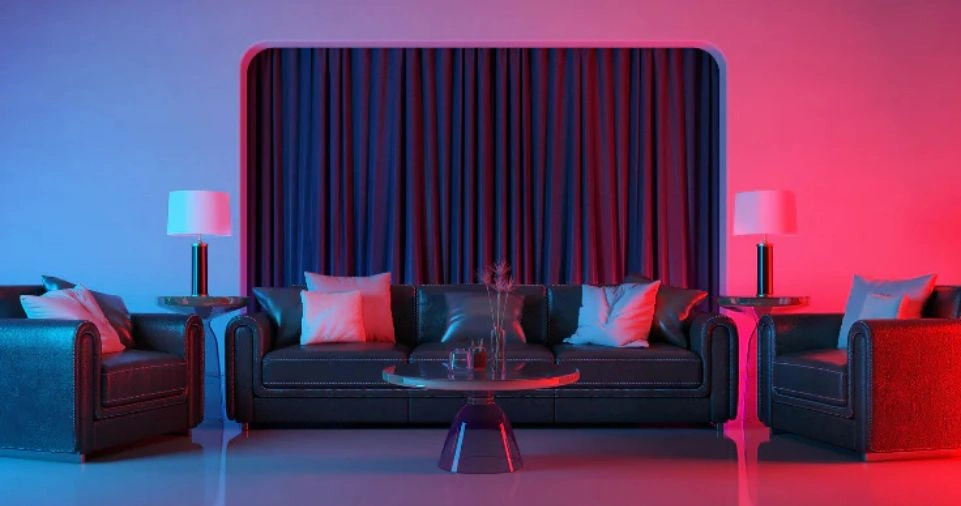
Color psychology can enhance the atmosphere of a room. Here’s a breakdown of how to use colored lights effectively:
- Blue Light: Calming and serene; ideal for bedrooms and bathrooms.
- Yellow Light: Invites warmth and happiness; perfect for living rooms and kitchens.
- Red Light: Adds passion and energy; use sparingly in bedrooms or dining areas.
- Green Light: Balances and soothes; great for meditation rooms or reading nooks.
Pro Tip: Smart bulbs let you experiment with various colors without permanent changes.
ALSO READ: How to Decorate with Indoor Plants for a Fresh Look
Innovative Lighting Ideas
Layered Lighting
Combine ambient, task, and accent lighting for versatility. For example, in a dining room, pair a chandelier (ambient) with wall sconces (accent) and a pendant light over the table (task).
Statement Fixtures
Invest in bold, artistic fixtures to serve as focal points in rooms like the living area or dining room.
Natural Light Integration
Use sheer curtains or strategically placed mirrors to maximize natural light.
Smart Lighting Systems
Control your lighting with apps, timers, or voice commands for effortless ambiance adjustments.
LED Technology
LED lights are energy-efficient and versatile. Use them in creative ways, such as strip lighting under furniture or color-changing bulbs.
Tables for Quick Reference
Ideal Lighting for Different Rooms
| Room | Ambient | Task | Accent |
|---|---|---|---|
| Living Room | Ceiling fixtures | Floor lamps | Wall sconces, spotlights |
| Kitchen | Recessed lights | Under-cabinet LEDs | Pendant lights |
| Bedroom | Dimmable ceiling lights | Bedside lamps | LED strips behind furniture |
| Bathroom | Ceiling lights | Vanity lighting | LED strips around mirrors |
| Dining Room | Chandelier | Pendant lights over table | Wall-mounted fixtures |
Lighting and Color Temperature Chart
| Activity | Recommended Color Temperature (Kelvin) |
|---|---|
| Relaxing | 2000K–3000K |
| Cooking | 3100K–4500K |
| Reading/Working | 4600K–6500K |
| Decorative Lighting | Adjustable (smart bulbs) |
Practical Tips for Effective Lighting
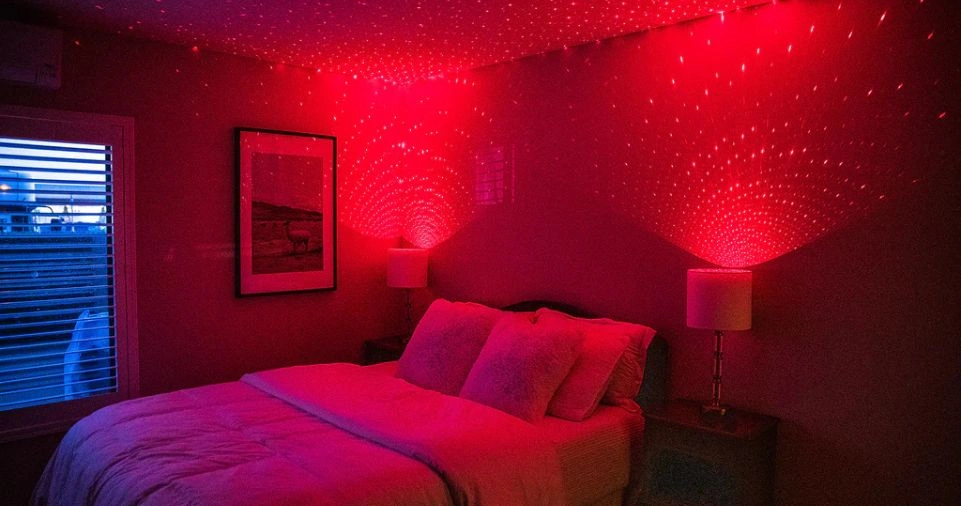
- Dimmer Switches: Add flexibility to lighting by installing dimmer switches in main living spaces.
- Layering Light: Use a combination of light sources to create depth and visual interest.
- Fixture Placement: Avoid harsh shadows by positioning lights at different levels.
- Bulb Selection: Choose bulbs with the appropriate wattage and temperature for each space.
- Experiment with Shadows: Use uplighting or downlighting to create dramatic effects.
ALSO READ: How to Upgrade Your Kitchen on a Budget?
Conclusion
Lighting is a powerful tool for setting the mood in any room. By understanding the basics of lighting, considering the purpose of each space, and integrating innovative techniques, you can create a harmonious and visually appealing environment.
Whether you’re hosting a dinner party or relaxing after a long day, the right lighting can make all the difference.
Start experimenting with your lighting design today to transform your home into a haven of mood-enhancing beauty.


